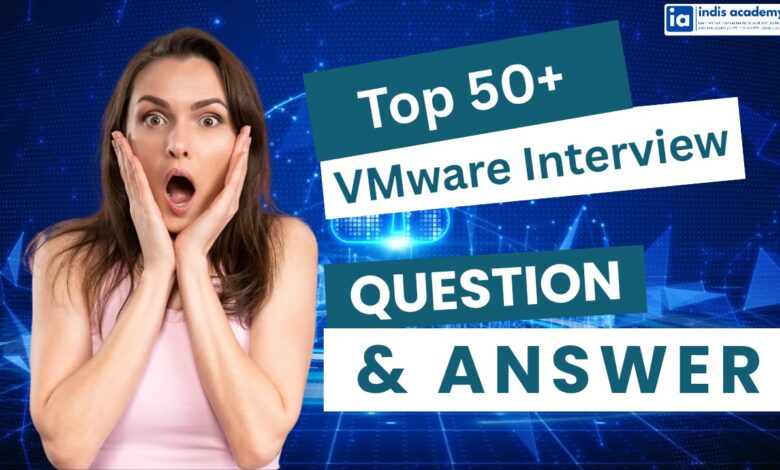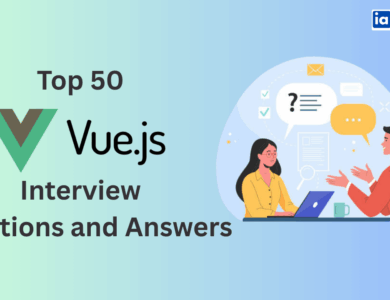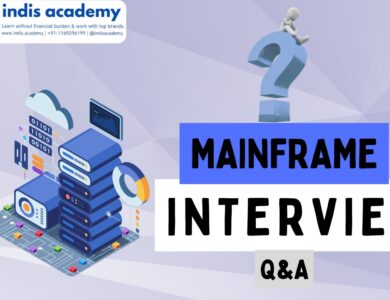Top 50+ VMware Interview Questions and Answers
Prepare for your VMware interviews with this expert-curated list of 50+ questions and answers. Covers vSphere, ESXi, vCenter, snapshots, clustering, and more.

Planning to crack your next VMware interview? Whether you’re an aspiring IT professional or a seasoned virtualization expert, preparing for VMware interviews requires a solid understanding of virtualization concepts, VMware products like vSphere and ESXi, and real-world troubleshooting skills.
VMware is a global leader in virtualization and cloud infrastructure technologies. From data centers to hybrid cloud deployments, VMware solutions like vCenter, NSX, vSAN, and Horizon are powering mission-critical systems in enterprises worldwide. As businesses continue to shift toward virtual environments and cloud-native infrastructure, demand for VMware-certified professionals is on the rise.
This guide is designed to help both freshers and experienced professionals confidently prepare for VMware interviews. We’ve curated 50+ interview questions and answers that span basic concepts, configuration, storage, networking, and real-world scenarios — all tailored to match the latest industry expectations.
Whether you’re targeting roles like VMware Admin, Cloud Engineer, or System Architect, this list will serve as your go-to prep material.
👉 Bookmark this page and share it with your peers — especially when the interview clock is ticking and revision time is short!
Top 50+ VMware Interview Questions and Answers
Whether you’re targeting roles like VMware Admin, Cloud Engineer, or System Architect, this list will serve as your go-to prep material. Here check our top 50+ VMware Interview Questions and Answers:
Basic VMware Interview Questions and Answers
This section covers fundamental concepts that are commonly asked in entry-level VMware interviews. If you’re just starting out or applying for roles like Support Engineer, System Administrator, or VMware Intern, make sure you’re confident with these basics.
Q1. What is VMware?
Answer:
VMware is a global software company that provides cloud computing and virtualization solutions. It enables the creation and management of virtual machines (VMs), allowing multiple operating systems to run on a single physical server, improving efficiency and reducing hardware costs.
Q2. What is virtualization in simple terms?
Answer:
Virtualization is the process of creating a software-based (virtual) version of something—such as servers, storage devices, networks, or operating systems. It allows multiple virtual systems to run on a single physical hardware resource, optimizing usage and scalability.
Q3. What is a hypervisor?
Answer:
A hypervisor is a layer of software that enables virtualization. It sits between the hardware and virtual machines and allocates resources like CPU, memory, and storage to each VM. VMware uses a Type 1 hypervisor called ESXi, which runs directly on the hardware.
Q4. What is the difference between VMware ESXi and VMware Workstation?
Answer:
- VMware ESXi is a Type 1 hypervisor installed directly on physical servers. It’s used in enterprise data centers for running multiple VMs in production.
- VMware Workstation is a Type 2 hypervisor that runs on a desktop operating system like Windows or Linux. It’s used for testing and development.
Q5. What are the key benefits of virtualization?
Answer:
Better resource utilization
Cost savings on hardware
Simplified management
Easy backups and disaster recovery
Faster provisioning and scalability
Q6. What is vSphere in VMware?
Answer:
vSphere is VMware’s suite of server virtualization products. It includes ESXi (the hypervisor) and vCenter Server (management platform). Together, they provide a complete virtualization solution for managing and running virtual infrastructures.
Q7. What is vCenter Server?
Answer:
vCenter Server is the centralized management tool for VMware vSphere environments. It enables administrators to manage multiple ESXi hosts and VMs from a single console, and supports features like vMotion, HA, and DRS.
Q8. What is VMotion?
Answer:
vMotion is a feature in VMware that allows live migration of running virtual machines from one ESXi host to another without any downtime. It’s crucial for load balancing and maintenance activities.
Q9. What is a virtual machine (VM)?
Answer:
A virtual machine is a software emulation of a physical computer. It includes its own virtual CPU, memory, disk, and network interface and can run an operating system and applications like a real computer.
Q10. What are VMware Tools?
Answer:
VMware Tools is a suite of utilities installed in a guest operating system to enhance the performance of the virtual machine. It enables features like improved graphics, time synchronization, and smooth mouse operations.
VMware ESXi Interview Questions and Answers
VMware ESXi is the core hypervisor component of the vSphere suite and is often at the heart of technical interviews for system administrators and virtualization engineers. These questions will test your understanding of ESXi installation, architecture, configuration, and maintenance.
Q11. What is VMware ESXi?
Answer:
VMware ESXi is a bare-metal hypervisor developed by VMware. It installs directly on a physical server and allows you to run multiple virtual machines on the same hardware. ESXi replaces the traditional operating system and provides a lightweight virtualization layer.
Q12. What is the difference between ESX and ESXi?
Answer:
- ESX had a Linux-based service console, which added overhead and potential security risks.
- ESXi is more lightweight and secure, with no service console. It uses a direct console user interface (DCUI) and can be managed remotely using vCenter.
VMware discontinued ESX and now only provides ESXi as the standard hypervisor.
Q13. What is DCUI in ESXi?
Answer:
DCUI (Direct Console User Interface) is a text-based interface used to manage ESXi servers locally. It allows administrators to configure basic settings such as IP addresses, hostnames, and restart management agents.
Q14. How do you install ESXi on a server?
Answer:
Steps to install ESXi:
- Download the ESXi ISO from VMware.
- Create a bootable USB or burn the ISO to a CD/DVD.
- Boot the physical server from the installation media.
- Follow the guided installation to select the drive and set up credentials.
- Once installed, configure the network settings using DCUI.
Q15. How do you access and manage an ESXi host?
Answer:
You can manage ESXi hosts using:
- vSphere Client (HTML5): GUI to access ESXi remotely via web browser.
- DCUI: Local management interface for basic configuration.
- SSH: For command-line management (must be enabled).
- vCenter Server: For centralized management in multi-host environments.
Q16. How do you take a backup of an ESXi host configuration?
Answer:
You can back up ESXi host configuration using:
vim-cmd hostsvc/firmware/backup_config
Or via the vSphere CLI or PowerCLI. This creates a .tgz file which can be downloaded and restored later using the restore_config command.
Q17. What are some common logs available in ESXi and where are they located?
Answer:
- /var/log/vmkernel.log – Kernel-related events
- /var/log/hostd.log – Host management service logs
- /var/log/vpxa.log – vCenter agent logs
- /var/log/syslog.log – System-related messages
These logs help in diagnosing performance and connectivity issues.
Q18. Can you explain the ESXi boot process?
Answer:
- The server boots from BIOS or UEFI and loads the ESXi image.
- The ESXi kernel initializes and loads drivers.
- VMkernel starts and initializes system components.
- Services like hostd and vpxa start for management.
- The host becomes ready to run virtual machines and be managed via vCenter.
vSphere and vCenter Interview Questions and Answers
In a VMware ecosystem, vSphere acts as the complete virtualization platform, and vCenter Server is its centralized management component. These tools are central to managing hosts, clusters, virtual machines, and services like HA, DRS, and vMotion. Let’s explore common interview questions in this domain:
Q19. What is vSphere in VMware?
Answer:
vSphere is VMware’s flagship virtualization platform. It includes two main components:
- ESXi (the hypervisor that runs VMs)
- vCenter Server (the management interface)
vSphere allows you to manage compute, storage, and networking resources in a virtualized environment.
Q20. What is the role of vCenter Server?
Answer:
vCenter Server is a centralized management platform that lets you manage multiple ESXi hosts, virtual machines, clusters, and resources from a single console. It enables advanced features like:
- vMotion
- HA (High Availability)
- DRS (Distributed Resource Scheduler)
- Templates & Cloning
Q21. What is the difference between vSphere, ESXi, and vCenter?
Answer:
- ESXi is the hypervisor that runs directly on hardware.
- vCenter Server manages multiple ESXi hosts and their resources.
- vSphere is the name of the entire suite, including both ESXi and vCenter.
Q22. What is vMotion?
Answer:
vMotion is a feature in vSphere that allows live migration of running VMs from one ESXi host to another without downtime. It ensures business continuity during maintenance or load balancing.
Q23. What is DRS in VMware?
Answer:
DRS (Distributed Resource Scheduler) automatically balances computing workloads across ESXi hosts within a cluster based on CPU and memory usage. It works with vMotion to move VMs as needed.
Q24. What is HA (High Availability) in vSphere?
Answer:
VMware HA ensures high availability of VMs in a cluster. If a host fails, the affected VMs are automatically restarted on another host in the cluster with minimal downtime.
Q25. What is vSphere Web Client?
Answer:
vSphere Web Client is a browser-based interface used to manage vCenter Server and the entire virtual infrastructure. VMware now encourages the use of the HTML5-based vSphere Client instead of the legacy Flash client.
Q26. How do you upgrade vCenter Server?
Answer:
To upgrade vCenter Server:
- Take a backup of the vCenter database and configuration.
- Download the latest version ISO.
- Use the vCenter Server Appliance (VCSA) installer for GUI-based upgrades or CLI.
- Follow the upgrade wizard and validate settings.
- Post-upgrade, verify all services and reconnect ESXi hosts if needed.
Q27. What is a vApp in VMware?
Answer:
A vApp is a container for one or more virtual machines that work together as a solution. vApps can have resource allocation settings, startup/shutdown order, and application-level policies.
Storage & Snapshots Interview Questions and Answers
Understanding how storage works in VMware — including VMFS, datastores, snapshots, and vSAN — is essential for interview success, especially for infrastructure and cloud operations roles. Below are the most commonly asked questions related to VMware storage.
Q28. What is VMFS in VMware?
Answer:
VMFS (Virtual Machine File System) is a high-performance clustered file system used by VMware ESXi hosts to store virtual machine files, including VMDKs, snapshots, and logs. It allows multiple hosts to access the same datastore concurrently.
Q29. What is a datastore in VMware?
Answer:
A datastore is a storage container in VMware used to store VM files. It can be:
- VMFS-based (block storage)
- NFS-based (file storage)
- vSAN-based (object storage)
Datastores can be shared across multiple ESXi hosts.
Q30. What is a VMware snapshot?
Answer:
A snapshot captures the exact state of a VM at a specific point in time, including its disk, memory, and settings. It’s commonly used for backup before changes or updates. Snapshots are not backups and should be used temporarily.
Q31. How does a snapshot work in VMware?
Answer:
When a snapshot is taken:
- A new delta disk is created (.vmdk)
- All write operations go to the delta disk
- The original disk becomes read-only
This allows the VM to be rolled back by discarding the delta changes.
Q32. What is the difference between a snapshot and a clone?
| Feature | Snapshot | Clone |
|---|---|---|
| Purpose | Point-in-time rollback | Full duplicate of a VM |
| Storage Used | Less (uses delta disks) | More (copies all disk files) |
| Performance | Can degrade over time if retained | Performs like a normal VM |
| Use Case | Testing changes, patching | Deploying multiple VM instances |
Q33. What is vSAN in VMware?
Answer:
VMware vSAN (Virtual SAN) is a hyper-converged storage solution that pools together local disks from multiple ESXi hosts to create a distributed shared datastore. It eliminates the need for traditional SAN/NAS hardware.
Q34. What is RDM in VMware storage?
Answer:
RDM (Raw Device Mapping) allows a VM to directly access a physical storage device (LUN). It’s useful in clustering scenarios or when a VM needs to interact with SAN-level services like snapshots from array.
Q35. How do you monitor disk performance and latency in vSphere?
Answer:
You can monitor disk performance using:
- vSphere Client → Performance Charts
- esxtop command-line utility for real-time stats
- Metrics like Kernel Latency, Device Latency, and Queue Depth are key indicators
Networking in VMware Interview Questions and Answers
Networking is a core aspect of VMware infrastructure. Interviews often include questions about virtual switches, VLANs, port groups, and network traffic control. These questions are important for roles like VMware Admin, Network Engineer, and Cloud Architect.
Q36. What is a virtual switch in VMware?
Answer:
A virtual switch (vSwitch) is a software-based switch that connects virtual machines (VMs) to each other and to the physical network. It functions similarly to a physical switch, handling network traffic inside the host.
Q37. What are the types of virtual switches in VMware?
Answer:
There are two main types:
- Standard vSwitch (vSS): Managed per-host, suitable for small environments.
- Distributed vSwitch (vDS): Managed via vCenter, allows centralized configuration and consistent networking across multiple hosts.
Q38. What is a port group in VMware?
Answer:
A port group is a template for configuring network settings for VMs. It defines things like VLAN ID, traffic shaping, and security policies. VMs connected to the same port group share the same configuration.
Q39. What is the difference between a standard switch and a distributed switch?
| Feature | Standard vSwitch | Distributed vSwitch |
|---|---|---|
| Configuration | Per host | Centralized via vCenter |
| Scalability | Limited | Highly scalable |
| Use Case | Small setups | Large, multi-host environments |
| Advanced Features | Limited | Supports NetFlow, port mirroring |
Q40. How does NIC teaming work in VMware?
Answer:
NIC teaming allows multiple physical NICs to be grouped together to provide:
- Load balancing
- Failover protection
This improves availability and performance. Teaming policies include: - Route based on originating virtual port
- Route based on IP hash
- Route based on source MAC hash
Q41. What is VLAN tagging in vSphere networking?
Answer:
VLAN tagging is the process of assigning VLAN IDs to network traffic to segment it. In VMware, this is configured at the port group level using:
-
VST (Virtual Switch Tagging) – Most common, VLAN tag is added by the vSwitch.
Q42. What is VMkernel NIC and its purpose?
Answer:
A VMkernel NIC (vmk) is used by the ESXi host for system traffic such as:
- vMotion
- iSCSI/NFS
- Management traffic
- Fault Tolerance
Each VMkernel port has an IP address and is assigned to a specific function.
Advanced VMware Interview Questions and Answers
This section is for candidates with 5+ years of experience or those applying for L2/L3 VMware roles, Cloud Engineers, and Virtualization Architects. These questions assess deep technical knowledge, troubleshooting, and enterprise-level implementations.
Q43. What is the difference between VMDK and RDM?
| Feature | VMDK (Virtual Disk) | RDM (Raw Device Mapping) |
|---|---|---|
| Storage Type | File-based (stored on a datastore) | Direct LUN access (block-level) |
| Use Case | Most common for VMs | Clustering, SAN snapshot integration |
| Performance | Slightly slower (file system overhead) | Higher performance (direct access) |
| Snapshot Support | Full snapshot support | Limited snapshot capability |
Q44. How do you troubleshoot a VM that is not powering on?
Answer:
- Check for insufficient CPU/memory on host
- Review VM log files for errors (
vmware.log) - Ensure there are no file locks on VM files
- Verify disk space on datastore
- Look for HA failover issues
- Check permissions and user roles
Q45. What is VMware Fault Tolerance (FT)?
Answer:
VMware FT provides continuous availability for VMs by creating a live shadow instance on a separate host. If the primary VM fails, the secondary takes over instantly with zero data loss. It requires:
- Shared storage
- VMkernel FT network
- CPUs with FT compatibility
Q46. What is vSphere Replication?
Answer:
vSphere Replication is a hypervisor-based VM replication feature that replicates VM data from a primary site to a recovery site. It’s used for disaster recovery and allows custom RPO settings per VM.
Q47. How do you secure a VMware environment?
Answer:
- Use role-based access control (RBAC)
- Enable lockdown mode on ESXi
- Restrict SSH access
- Use VM encryption (vSphere 6.5+)
- Keep vCenter & ESXi patched
- Disable unnecessary services
- Isolate management and VM networks
Q48. What is Content Library in VMware?
Answer:
A content library is a central repository for VM templates, ISO images, scripts, etc. It supports versioning, replication across sites, and helps maintain consistency in multi-cluster environments.
Q49. What is the PSC (Platform Services Controller)?
Answer:
PSC is a component of vCenter that handles:
- Single Sign-On (SSO)
- Licensing
- Certificate Authority
- Directory Services
As of vSphere 7.0, embedded PSC architecture is used — external PSC is deprecated.
Q50. How can PowerCLI be used in VMware environments?
Answer:
PowerCLI is a set of PowerShell modules for managing VMware environments via scripts. Examples:
Get-VM # List all VMs Get-VMHost # Get host info New-VM # Create a new VM Start-VM # Power on VM
PowerCLI is widely used for automation and bulk operations.
Q51. What is EVC in VMware?
Answer:
EVC (Enhanced vMotion Compatibility) ensures that VMs can be migrated across different generations of CPUs by masking CPU features. It prevents vMotion errors due to CPU incompatibilities.
Scenario-Based VMware Interview Questions
These real-world scenarios are often asked in mid to senior-level interviews to test your practical troubleshooting, architecture understanding, and decision-making skills. Prepare to answer with step-by-step logic and real-time actions you’d take.
Q52. A VM is running very slow. How do you troubleshoot this issue?
Answer:
Step-by-step approach:
- Check VM resource usage (CPU, memory, disk I/O).
- Use esxtop or vSphere Performance Charts to analyze bottlenecks.
- Verify if the host is overcommitted.
- Check VMware Tools status and update if needed.
- Validate if any snapshot is running for a long time.
- Look at disk latency and datastore health.
- Check for ballooning, swapping, or CPU ready time.
- Reboot if required after remediation.
Q53. You need to migrate 50 VMs with zero downtime. How would you do it?
Answer:
- Use vMotion for live migration.
- Ensure shared datastore and compatible CPUs or EVC enabled.
- Schedule migrations during non-peak hours.
- Monitor migration using vCenter.
- Validate application functionality post-migration.
Q54. A vCenter service is not starting. What do you do?
Answer:
- SSH or console access to vCenter Appliance (VCSA).
- Run:
service-control --status
- to check service statuses.
- Start services manually:
service-control --start --all
- Check logs:
/var/log/vmware/vpxd/ - Validate disk space, certificates, and DB connectivity.
- Reboot as a last resort.
Q55. You are tasked with setting up a DR solution. What options do you consider?
Answer:
- vSphere Replication: For per-VM level replication.
- SRM (Site Recovery Manager): For orchestrated DR with automation.
- Third-party tools: Veeam, Zerto, etc.
- Ensure RTO/RPO alignment with business expectations.
- Test failover regularly.
Q56. How would you perform a rolling patch upgrade on multiple ESXi hosts with minimal disruption?
Answer:
- Put one host in maintenance mode.
- vMotion all VMs to another host.
- Apply the patch via vSphere Lifecycle Manager or CLI.
- Reboot and validate.
- Exit maintenance mode.
- Repeat for next host in the cluster.
Tips to Crack VMware Interviews
If you’re serious about landing a job in virtualization or cloud infrastructure, these preparation tips will help you stand out in VMware interviews:
✅ 1. Master the Core Concepts
- Understand virtualization, hypervisors, VM lifecycle, and resource allocation.
- Study how ESXi and vCenter work together.
✅ 2. Set Up a Home Lab
- Use VMware Workstation or ESXi Free Edition.
- Practice VM creation, snapshot management, cloning, and basic networking.
✅ 3. Learn PowerCLI
- Automating daily tasks using PowerCLI scripts is highly valued.
- Even basic knowledge of scripting shows initiative and efficiency.
✅ 4. Understand Real-World Scenarios
- Practice troubleshooting performance issues, HA failovers, and storage outages.
- Prepare to answer “What would you do if…” type questions with structured logic.
✅ 5. Stay Updated with VMware Releases
- VMware evolves rapidly — know the latest changes in vSphere 7 and 8.
- Understand deprecated features (e.g., PSC external nodes) and new ones (like vSphere Lifecycle Manager).
✅ 6. Get Certified
- VCP (VMware Certified Professional) certification adds credibility and shows commitment.
- If you’re certified, mention the version and highlight hands-on lab work.
Conclusion
VMware continues to be a critical player in the cloud and virtualization industry. Whether you’re aiming for your first job or a senior architect role, strong VMware skills can open doors to high-paying and challenging IT roles.
In this guide, we covered 50+ interview questions, real-world scenarios, and expert tips — all designed to give you the edge in your upcoming VMware interview.
👉 Bookmark this article and come back to revise it before interviews.
💬 Got a question or an answer to add? Drop it in the comments and let’s grow this resource together!
FAQs – VMware Interview Preparation
Q1. Is VMware a good career option?
Yes, VMware skills are in high demand across industries, especially in cloud, data center, and DevOps roles.
Q2. How much does a VMware Admin earn?
In India, salaries range from ₹4 LPA to ₹15+ LPA depending on experience. In the US, it ranges between $70,000 to $130,000+ annually.
Q3. Do I need to be certified to get a VMware job?
Certification isn’t mandatory but VCP, VCAP, or VCDX certifications significantly improve your job prospects and salary.
Q4. What is the best way to practice VMware hands-on?
Set up a home lab using VMware Workstation, or explore free labs available on VMware’s official website.
See more job interview Q&A content





